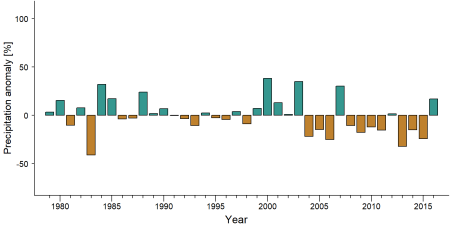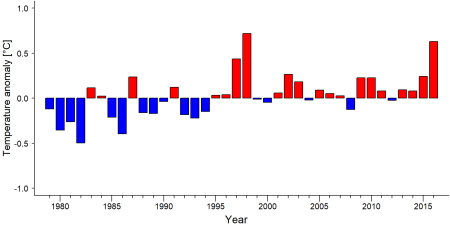Difference between revisions of "Bambidie Forestry Concession"
(Created page with "<!-- INSTRUCTIONS FOR UPLOADING SITE INFORMATION - Wiki pages contain information in paragraphs, tables, lists, and images. - Text and images are not restricted, and their for...") |
|||
| Line 68: | Line 68: | ||
|Haurez et al. 2014 | |Haurez et al. 2014 | ||
| | | | ||
| − | | | + | | |
|} | |} | ||
Revision as of 04:18, 7 March 2024
Central Africa > Gabon > Bambidie Forestry Concession
Summary
- Central chimpanzees (Pan troglodytes troglodytes) and Western lowland gorillas (Gorilla gorilla gorilla) are present in Bambidie.
- It has been estimated that 20 gorillas occur in the site.
- The Western lowland gorilla’s population trend is stable.
- The site has a total size of 13 km².
- Key threats to Western lowland gorillas are poaching, logging and roads.
- Conservation activities have focused on anti-poaching patrols, provision of alternative livelihood activities to local populations, forest certification as “primate friendly” concession, and environmental education.
Site characteristics
Bambidie is a forest concession that was logged for the first time in the early 1990s, and for the second time in 2013. The average exploitation rate for this second rotation was 1.01 trees/hectare (or 8.34 m³ / hectare). The concession is FSC certified and the company applies sustainable forest management practices. Several villages are included in the concession. Animal populations are relatively well preserved in the area. Key animal species found at this site are Western lowland gorilla, central chimpanzee, forest elephant, giant pangolin, and panther (Haurez et al. 2014, Haurez et al. 2016).
Table 1. Basic site information for Bambidie Forestry Concession
| Area | 13 km² |
| Coordinates | 0.866667, 13.100000 |
| Designation | Forestry concession |
| Habitat types | Subtropical/tropical moist lowland forest |
IUCN habitat categories Site designations
Ape status
The last inventory followed two previous surveys, one carried out before the second rotation (January-July 2021) and the second 4-6 months after the second operation (March 2014). Comparison of the results of the three inventories shows a significant drop in gorilla density 4 months after the second rotation, and a significant increase in gorilla density between 4 months and 1 year after the second rotation. The density observed 1 year after the second rotation is not significantly different from the initial density (before the second rotation).
Table 2. Ape population estimates in Bambidie Forestry Concession
| Species | Year | Abundance estimate (95% CI) | Density estimate [ind./ km²] (95% CI) | Encounter rate (nests/km) | Area | Method | Source | Comments | A.P.E.S. database ID |
|---|---|---|---|---|---|---|---|---|---|
| Gorilla gorilla gorilla | 2014 | 20 | 1.5 | 0.88 | 9 sq.km | Line transects (Distance) and index survey (reconnaissance walk) | Haurez et al. 2014 |
Threats
The main threat is subsistence hunting. However, the level of this threat is relatively low. The logging company has set up various processes to fight against poaching, and to limit the pressure of subsistence hunting.
Table 3. Threats to apes in Bambidie Forestry Concession
| Category | Specific threats | Threat level | Quantified severity | Description | Year of threat |
|---|---|---|---|---|---|
| 1. Residential & commercial development | Absent | ||||
| 2. Agriculture & aquaculture | Absent | ||||
| 3. Energy production & mining | Absent | ||||
| 4. Transportation & service corridors | 4.1 Roads & railroads | Low | Presence of roads within the logging concession and presence of a national road (Haurez et al. 2014). | Ongoing (2014) | |
| 5. Biological resource use | 5.1 Hunting & collecting terrestrial animals | Medium | Encounter rate of human signs: 0.094 signs/km | All signs of human activities recorded. | Ongoing (2014) |
| 5.3 Logging & wood harvesting | Low | Logging concession sustainably managed (Haurez et al. 2016). | Ongoing (2016) | ||
| 6. Human intrusion & disturbance | Unknown | ||||
| 7. Natural system modifications | Absent | ||||
| 8. Invasive & other problematic species, genes, diseases | Unknown | ||||
| 9. Pollution | Unknown | ||||
| 10. Geological Events | Absent | ||||
| 11. Climate change & severe weather | Unknown | ||||
| 12. Other options | Absent |
Conservation activities
Table 4. Conservation activities in Bambidie Forestry Concession
| Category | Specific activity | Description | Year of activity |
|---|---|---|---|
| 1. Residential & commercial development | Not reported | ||
| 2. Agriculture & aquaculture | Not reported | ||
| 3. Energy production & mining | Not reported | ||
| 4. Transportation & service corridors | 4.4. Reduce road widths | Ongoing (2021) | |
| 4. Transportation & service corridors | 4.8. Re-use old roads rather than building new roads | Ongoing (2021) | |
| 5. Biological resource use | 5.4. Implement road blocks to inspect cars for illegal primate bushmeat | Ongoing (2021) | |
| 5. Biological resource use | 5.6. Conduct regular anti-poaching patrols | Ongoing (2021) | |
| 5. Biological resource use | 5.14. Inform hunters of the dangers (e.g., disease transmission) of wild primate meat | Ongoing (2021) | |
| 5. Biological resource use | 5.17. Provide sustainable alternative livelihoods; establish fish- or domestic meat farms | Ongoing (2021) | |
| 5. Biological resource use | 5.30. Incorporate forested corridors or buffers into logged areas | Ongoing (2021) | |
| 5. Biological resource use | 5.31. Close non-essential roads as soon as logging operations are complete | Ongoing(2021) | |
| 5. Biological resource use | 5.35. Certify forest concessions and market their products as ‘primate friendly’ | Ongoing(2021) | |
| 5. Biological resource use | 5.36. Provide domestic meat to workers of the logging company to reduce hunting | Ongoing(2021) | |
| 6. Human intrusion & disturbance | Not reported | ||
| 7. Natural system modifications | Not reported | ||
| 8. Invasive & other problematic species, genes, diseases | Not reported | ||
| 9. Pollution | Not reported | ||
| 10. Education & Awareness | 10.1. Educate local communities about primates and sustainable use | Ongoing(2021) | |
| 10. Education & Awareness | 10.3. Install billboards to raise primate conservation awareness | Ongoing(2021) | |
| 11. Habitat Protection | Not reported | ||
| 12. Species Management | Not reported | ||
| 13. Livelihood; Economic & Other Incentives | Not reported |
Conservation activities list (Junker et al. 2017)
Challenges
The financial resources of the company are dedicated to logging. The conservation of fauna is an obligation (in particular within the framework of the FSC), but remains a "non-priority" activity.
Table 5. Challenges reported for Bambidie Forestry Concession
| Challenge | Source |
|---|---|
| Lack of financial support | Haurez (pers. communication) |
Research activities
Research activities carried out in Bambidie concern the impact of logging on western lowland gorillas, the impact of large fauna on forest regeneration (seed dispersal by gorillas, elephants), and hunting activities and their impacts.
Documented behaviours
Table 6. Ape behaviors reported for Bambidie Forestry Concession
| Behavior | Source |
|---|---|
| Not reported |
Exposure to climate change impacts
As part of a study on the exposure of African great ape sites to climate change impacts, Kiribou et al. (2024) extracted climate data and data on projected extreme climate impact events for the site. Climatological characteristics were derived from observation-based climate data provided by the Inter-Sectoral Impact Model Intercomparison Project (ISIMIP, www.isimip.org). Parameters were calculated as the average across each 30-year period. For 1981-2010, the EWEMBI dataset from ISIMIP2a was used. For the two future periods (2021-2050 and 2071-2099) ISIMIP2b climate data based on four CMIP5 global climate models were used. For future projections, two Representative Concentration Pathways (RCP) were used. RCP 2.6 is a scenario with strong mitigation measures in which global temperatures would likely rise below 2°C. RCP 6.0 is a scenario with medium emissions in which global temperatures would likely rise up to 3°C by 2100. For the number of days with heavy precipitation events, the 98th percentile of all precipitation days (>1mm/d) was calculated for the 1979-2013 reference period as a threshold for a heavy precipitation event. Then, for each year, the number of days above that threshold was derived. The figures on temperature and precipitation anomaly show the deviation from the mean temperature and mean precipitation for the 1979-2013 reference period. The estimated exposure to future extreme climate impact events (crop failure, drought, river flood, wildfire, tropical cyclone, and heatwave) is based on a published dataset by Lange et al. 2020 derived from ISIMIP2b data. The same global climate models and RCPs as described above were used. Within each 30-year period, the number of years with an extreme event and the average proportion of the site affected were calculated (Kiribou et al. 2024).
Table 7. Estimated past and projected climatological characteristics in Bambidie Forestry Concession
| 1981-2010 | 2021-2050, RCP 2.6 | 2021-2050, RCP 6.0 | 2071-2099, RCP 2.6 | 2071-2099, RCP 6.0 | |
| Mean temperature [°C] | 25.5 | 26.6 | 26.5 | 26.8 | 27.8 |
| Annual precipitation [mm] | 4053 | 4123 | 4127 | 4211 | 4214 |
| Max no. consecutive dry days (per year) | 38.5 | 20.9 | 18.4 | 19.8 | 17.4 |
| No. days with heavy precipitation (per year) | 6.7 | 8.5 | 8.6 | 8.6 | 9.6 |
Table 8. Projected exposure of apes to extreme climate impact events in Bambidie Forestry Concession
| No. of years with event (2021-2050, RCP 2.6) | % of site exposed (2021-2050, RCP 2.6) | No. of years with event (2021-2050, RCP 6.0) | % of site exposed (2021-2050, RCP 6.0) | No. of years with event (2070-2099, RCP 2.6) | % of site exposed (2070-2099, RCP 2.6) | No. of years with event (2070-2099, RCP 6.0) | % of site exposed (2070-2099, RCP 6.0) | |
| Crop failure | 6.5 | 0 | 5.5 | 0 | 3 | 0 | 16.5 | 0 |
| Drought | 0 | 0 | 0 | 0 | 0 | 0 | 0 | 0 |
| Heatwave | 9.5 | 100 | 11 | 100 | 9 | 100 | 12.5 | 100 |
| River flood | 1 | 0.08 | 0.75 | 0.66 | 0 | 0 | 1.75 | 1.77 |
| Tropical cyclone | 0 | 0 | 0 | 0 | 0 | 0 | 0 | 0 |
| Wildfire | 30 | 0.46 | 30 | 0.4 | 29 | 0.45 | 29 | 0.39 |
References
Haurez, B., Petre, C. A., Vermeulen, C., Tagg, N., & Doucet, J. L. (2014). Western lowland gorilla density and nesting behavior in a Gabonese forest logged for 25 years: implications for gorilla conservation. Biodiversity and conservation, 23(11), 2669-2687.
Haurez, B., Tagg, N., Petre, C. A., Vermeulen, C., & Doucet, J. L. (2016). Short-term impact of selective logging on a western lowland gorilla population. Forest ecology and management, 364, 46-51.
Kiribou, R., Tehoda, P., Chukwu, O., Bempah, G., Kühl, H. S., Ferreira, J., ... & Heinicke, S. (2024). Exposure of African ape sites to climate change impacts. PLOS Climate, 3(2), e0000345.
Page completed by: Barbara Haurez Date: 18/05/2021

